Benefit for the Retired Boxer’s Foundation
“Boxing–it’s a hurtin’ game!” stated Ray “Boom Boom” Mancini at last night’s benefit screening of the new documentary “After The Last Round.” The lightweight champ is one of the most popular game players in the squared circle. And the pride of Youngstown knows all too well the consequences of the brutal wars in the ring as did the other pugilists who joined the WBA titlist at the gala event.
Also in attendance were fellow sluggers Alex Ramos, Ken Norton, Michael Bentt, Loreto Garza, 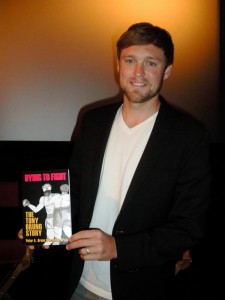 Tony “The Tiger” Lopez, Danny “Little Red” Lopez, Mando Muñiz, Jerry Cheatham, NFL’s Dwight Hicks (a two-time Super Champ with the San Francisco 49ers) and Hall of Fame boxing officials Joe Cortez, Richard Steele and Jack Reiss, among many other luminaries in the field.
Tony “The Tiger” Lopez, Danny “Little Red” Lopez, Mando Muñiz, Jerry Cheatham, NFL’s Dwight Hicks (a two-time Super Champ with the San Francisco 49ers) and Hall of Fame boxing officials Joe Cortez, Richard Steele and Jack Reiss, among many other luminaries in the field.
“After The Last Round,” directed by Ryan Pettey and produced by Patrick Moyer in association with Watercourse Road Productions, explores–and exposes–both the short-term and long-term effects endured from the never-ending pounding of the sweet science. I had the opportunity to view the movie with a roomful of champions at a private screening in Beverly Hills.
In this special report, you will hear the fighters’ reactions as the topic of brain injuries, dementia pugilistica and Parkinson’s-like symptoms were brought to the forefront on the big screen; a full review of the film to come in a future column.
Before the screening began, the fighters were celebrated and honored for their contributions in boxing. And at last night’s occasion, there was one very special ambassador greeting all the guests at the entrance, Alex “The Bronx Bomber” Ramos. The former middleweight is the Founder and President of the nonprofit Retired Boxer’s Foundation (RBF), known as “The Undisputed Champions for Dignity.” Ramos fights for the fighters’ rights, especially the forgotten ones that need it the most, and the screening was held in RBF’s honor.
With his joyous nature, Ramos’ face lit up with a genuine grin as each attendee made their way into the reception as you’ll see in these exclusive photos from the evening. As a Champagne toast was made in salute to these proud warriors, the fraternity of boxers streamed into the theatre in anticipation of “After The Last Round.”
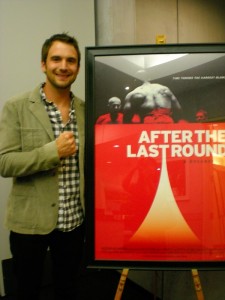 The riveting hour and a half film focuses on a side of boxing most never see. For every club fight or marquee matchup, after the fans drink their beer, cheer wildly for a knockout and exit the arena, what happens to the boxers–both the winners and the losers who leave it all in the ring?
The riveting hour and a half film focuses on a side of boxing most never see. For every club fight or marquee matchup, after the fans drink their beer, cheer wildly for a knockout and exit the arena, what happens to the boxers–both the winners and the losers who leave it all in the ring?
Unfortunately we see the effects when these modern-day gladiators finally hang up their gloves a few fights too late. The slurred speech, the shuffling walk, the slowed reflexes…and sometimes worse. Way worse, as in permanent brain damage, loss of eyesight or even death.
What price fame?
The topic isn’t an easy one to cover. Or one you can brush under the rug. With our love of boxing, we learn to respect the beauty while fearing the brutality. You can’t have one without the other. But you can change the rules of safety; you can adapt more precautionary measures for future fighters to come.
And that’s the one of the most important points made at the star-studded party.
The clearest message I received while seeing the boxers’ stories unfold is that brain injuries don’t discriminate. This is what the film shows as the camera follows both amateurs and pros, male and female, young and old before, during and after their blood-and-guts wars on the canvas. The lens captures painful slow motion images of fierce left hooks or crushing uppercuts as they connect with their human target at full force.
For me, the experience of watching the movie amongst a league of boxers was surreal, ironic and bittersweet. There were certain shots that made some in the audience wince and various scenes that made even the toughest warrior well up with tears. Yes, “After The Last Round” is often hard to watch with its honest and stark violence; but if you enjoy boxing, then this really is something you must watch.
The documentary, which premiered at the Santa Barbara Film Festival, draws out strong emotions and forces you to think of issues normally ignored. With it’s haunting and compelling images there’s no escape from the brutal reality of boxing. After the screening, everyone in the theatre was moved. Following the movie’s end credits, the young filmmakers hosted an at-times heated discussion on the perils fighters face inside and outside the ropes and of what, if any, preemptive strikes could be made in protecting the boxers.
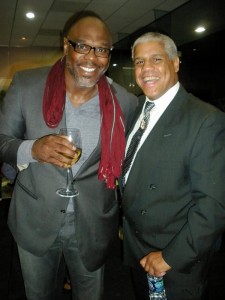 Former WBA Light Welterweight Champ Loreto Garza echoed the immediate reaction of the crowd. “That was a very powerful film. As a professional boxer, I’ve seen thousands of fighters go through the gym,” he said. “Boxing is a brutal sport; it’s not for everyone. This leaves you wondering one way or another; it’s a very, very powerful film.” The Sacramento fighter and I chatted after the screening as both he and his compadre, three-time world champ Tony Lopez, told me the movie brought back so many memories. Garza explained how as a young fighter he fought for pennies on the dollar in his quest for a world title. While both he and Lopez did become champions, many individuals who have incurred serious injury are no-name journeymen, average-skilled Joes or over-the-hill stepping stones who get used and abused in the sport.
Former WBA Light Welterweight Champ Loreto Garza echoed the immediate reaction of the crowd. “That was a very powerful film. As a professional boxer, I’ve seen thousands of fighters go through the gym,” he said. “Boxing is a brutal sport; it’s not for everyone. This leaves you wondering one way or another; it’s a very, very powerful film.” The Sacramento fighter and I chatted after the screening as both he and his compadre, three-time world champ Tony Lopez, told me the movie brought back so many memories. Garza explained how as a young fighter he fought for pennies on the dollar in his quest for a world title. While both he and Lopez did become champions, many individuals who have incurred serious injury are no-name journeymen, average-skilled Joes or over-the-hill stepping stones who get used and abused in the sport.
So who’s to blame?
That was another hot-button topic during the lively panel of VIP guests.
Former referee and current promoter Richard Steele says the finger can be pointed at everybody involved. “We need to be cautionary…everyone from the fighters, loved ones, managers and trainers should be involved.” But he also defended the sport he loves. “Boxing is a wonderful sport!” he added. “Especially for kids in poverty, for kids who have nothing.”
But once the fighters achieve any amount of fame and fortune, the consensus was of a need for guidelines in setting aside some of the purses earned. “Ninety-nine percent of the boxers are broke,” Las Vegas referee Joe Cortez opined. “They risk their lives. There should be small percentage from the four-rounders on, even 5% of their money put away, an annuity like a 401.”
The veteran referee also brought attention for the strictest safety measures on the canvas. “We have seminars around the world for officials,” the former Golden Gloves champ said. “We make it much safer, more effective, with improvements to save the fighter from taking any unnecessary punishment. We are here for the safety of the fighters!”
For “Boom Boom” Mancini, he’s had to live with the worst nightmare that any prizefighter can face: the death of his opponent. In 1982, Ray fought Duk Koo Kim, who later died from brain injuries suffered from their title fight. An emotional Mancini told those gathered, “Why him–and not me?” The arbitrary nature of who is maimed and who isn’t certainly is not lost on the famed fighter. “With my come forward style, I’d take some to give some,” he commented with the slightest of smile. “At the end of the day, I hope I gave more than I took!” Shaking his head, he still tries to come to grips with the unforeseen tragedy. “I didn’t kill him…It was a result of a fight.”
And he, too, still shows due respect for boxing. “It’s the sport I love and it made me the man I am 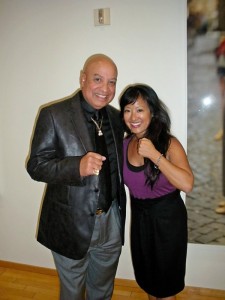 today,” summed up Mancini.
today,” summed up Mancini.
Defensive back Dwight Hicks, who endured plenty of on-field brain-jarring collisions himself, also stated adamantly, “I’d do it all again in a heartbeat!”
It’s that warrior mentality that these supreme athletes hold, for better or worse. These courageous pugs do not ask for sympathy.
Alex Ramos, who founded his charitable organization in 1998, is a living example of this. Speaking from the heart, the gregarious boxer who’s had his share of health issues, opened up last night as he stood and faced the moviegoers. “I’m not afraid to admit that I have frontal lobe and right temple damage to my brain,” Alex said he choked back the tears and cleared his throat. “I get emotional sometimes but it doesn’t bother me. I’m sharp as a tack!” He then implored everyone to share his zeal for helping others damaged by the brute sport we cheer on.
There were also plenty of lighter moments throughout the night when the champs recalled humorous memories from their careers. After seeing doctors’ interviews in the film, Tony Lopez announced to the crowd, “So now I know what those ‘lights’ that I saw were–I had a concussion!” He then joked, “And that’s how you learn to move your head more! Seeing the film brought back a lot of memories.”
The talk also turned to the subject of banning boxing altogether.
Many did not sugar-coat their opinions. One visitor from Colorado spoke about abolishing boxing. Pete Bruno and his family grew up around the sport. His son, Tony Bruno, was an amateur boxer 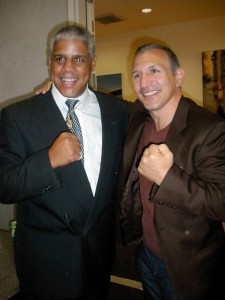 and college scholar who made the unfortunate decision to fight in a “smoker” style of brawl. After a series of blows, his only son ended up in the hospital with no happy ending. Outside the screening room, I met the father-son duo. Tony has made a partial recovery only after enduring 25 years of intense rehab. His father Pete is now obviously and deservedly critical of boxing and has even penned a book about his son’s tragedy. But he offered, “You see the good, the bad and the ugly of boxing. Let the viewers–you–decide for yourself!”
and college scholar who made the unfortunate decision to fight in a “smoker” style of brawl. After a series of blows, his only son ended up in the hospital with no happy ending. Outside the screening room, I met the father-son duo. Tony has made a partial recovery only after enduring 25 years of intense rehab. His father Pete is now obviously and deservedly critical of boxing and has even penned a book about his son’s tragedy. But he offered, “You see the good, the bad and the ugly of boxing. Let the viewers–you–decide for yourself!”
During his time in the Q&A session, director Ryan Pettey shared a statement that encompasses his film and the passionate discussion it brings forth. “It is a complex topic,” he stated simply, powerfully and positively. And in his documentary, he does create an awareness that can only bring the betterment of the sport.
Boxing matchmaker Pete Hironaka was there with his All Star Boxing associate, promoter Ed Holmes. After the screening when it was clear everyone remained deeply moved by the documentary, Pete said with a dose of solemn reality, “It’s very, very unfortunate–but it’s part of the game; it’s a by-product of boxing.”
For those in the fight game, it is a choice they make, by-product or not. So the next time you choose to watch boxing, remember everything it takes for these brave fighters to walk up those steps to the ring. Being part of the game and facing the consequences is a risk these gladiators are all too willing to take.
And long “After The Last Round,” they continue paying the price.
For more information: www.retiredboxers.org
Photos by Michele Chong


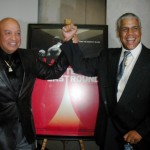
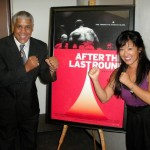


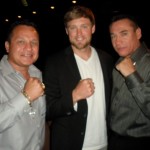



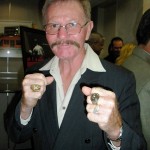
@ Carolyn Raymond For more information: http://www.retiredboxers.org
I’d like to purchase a copy of this film, can someone tell me where and if it’s available? I’ve been a timekeeper for thirty five years and seen lots and lots of “last rounds” in front of me. Still, I love the sport, it gives back as much as it takes in my view.
Comments are closed.